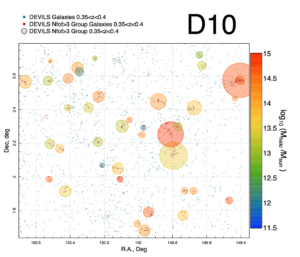Project area/S
- Distant Universe
Project Details

A map of the large-scales structure of the universe 4 Billion years ago. Galaxies are shown as small green/red points and dark matter halos as large circles (colour-coded by how massive they are). How are these halos impacting the properties of the galaxies that reside within them?
Within the large-scale structure of the Universe galaxies reside in gravitationally bound structures defined by their dark matter haloes (e.g. clusters, groups, filaments). These structures not only define the global distribution of baryonic material in the Universe, but can also leave strong imprints on the physical properties of galaxies by shaping their evolution. For example, satellite galaxies in massive dark matter haloes can have their gas stripped, removing the fuel for future star-formation, and significantly impacting the rate at which a galaxy grows. Determining how and to what degree the dark matter halo influences the evolution of galaxies is paramount to understanding the processes that shape our universe.
However, linking the galaxies (which we observe through their luminous material) to their underlying dark matter halo (which we can only infer through gravitational interactions) is fraught with difficulty. Typically, this requires highly costly and observationally intensive spectroscopy, limiting the number of galaxies we can associate with particular halos. This leads to small samples sizes and poor population statistics when trying to relate dark matter haloes to their impact on galaxy evolution.
In this project, we will develop a new technique to link galaxies without spectroscopic observations to induvial dark matter halos, dramatically increasing the sample sizes of galaxies with dark matter halo measurements. We will then use this new sample to explore the correlations between dark matter halo mass and star-formation in satellite galaxies, and determine how a galaxy’s local environment shapes it growth.
Student Attributes
Academic Background
Basic astronomy knowledge, preferably some understanding of galaxy evolution and cosmology
Computing Skills
Basic understanding of a coding language, preferably R, but any other is fine.
Training Requirement
Coding skills, data analysis, literature searchers,
Project Timeline
| Week 1 | Inductions and project introduction |
| Week 2 | Initial presentation |
| Week 3 | Understanding of halo distributions & galaxy photometric redshifts |
| Week 4 | Determining probabilistic overlap between galaxies and halos (i) |
| Week 5 | Determining probabilistic overlap between galaxies and halos (ii) |
| Week 6 | Exploring the stellar mass – halo mass relation |
| Week 7 | Selecting passive and star-forming galaxies |
| Week 8 | Passive fractions as a function of stellar mass and halo mass. |
| Week 9 | Final presentation |
| Week 10 | Final report |